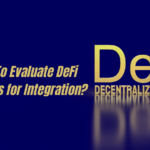In today’s rapidly evolving digital landscape, businesses are constantly seeking innovative solutions to streamline operations, enhance security, and build trust with stakeholders. One technology that has emerged as a game-changer across various industries is blockchain. This revolutionary system, often misunderstood due to its association with cryptocurrencies, offers far-reaching applications beyond digital currencies. In this comprehensive guide, we’ll explore blockchain basics, break down blockchain in simple terms, and highlight compelling blockchain use cases that are transforming businesses worldwide.
As organisations navigate the complexities of digital transformation, understanding and leveraging blockchain technology has become increasingly crucial. Whether you’re a startup looking to disrupt traditional markets or an established enterprise aiming to optimise processes or an individual exploring career opportunities in the field of blockchain or within a blockchain organisation, grasping the fundamentals of blockchain can open doors to unprecedented opportunities. Let’s embark on a journey to demystify this groundbreaking technology and discover how it can drive innovation, efficiency, and transparency across various sectors.
What is Blockchain?
At its core, blockchain is a distributed ledger technology that allows for secure, transparent, and tamper-resistant record-keeping. To explain blockchain in simple terms, imagine a digital ledger that is duplicated and distributed across a network of computers, rather than being stored in a single, centralised location. This decentralised nature is one of the key blockchain basics that sets it apart from traditional databases.
The term “blockchain” itself provides insight into its structure: it’s a chain of blocks, where each block contains a list of transactions or other data. Once a block is added to the chain, it is almost impossible to alter or remove, ensuring the integrity of the information stored within. This immutability is a foundation of blockchain technology, making it particularly valuable for applications requiring high levels of trust and security.
Key Features of Blockchain Technology
To fully grasp the potential of blockchain, it’s essential to understand its fundamental features in some more depth. These features form the building blocks of blockchain’s ability to create trust and efficiency in various processes.
Decentralization:
Blockchain operates on a distributed network of nodes, eliminating the need for a central authority. This decentralisation enhances security and reduces single points of failure.
Technical Implementation:
– Peer-to-peer network architecture
– Consensus mechanisms (e.g., Proof of Work, Proof of Stake)
– Distributed data storage
Immutability
Once data is recorded on the blockchain, it becomes extremely difficult to alter or delete, ensuring the integrity of the information.
Technical Approach:
– Cryptographic hashing
– Chaining of blocks
– Consensus validation for new entries
Transparency:
All transactions on a blockchain are visible to network participants, promoting accountability and trust.
Implementation Details:
– Public ledger accessible to all nodes
– Pseudonymous transactions (in public blockchains)
– Auditability through transaction history
Smart Contracts:
Self-executing contracts with the terms directly written into code, automating and enforcing agreement execution.
Technical Blueprint:
– Programmable logic embedded in the blockchain
– Trigger-based execution
– Integration with external data sources (oracles)
How Does Blockchain Work?
To truly grasp blockchain basics, it’s essential to understand the underlying mechanisms that make this technology so robust and revolutionary. If we have to understand in simple terms , blockchain operates on a few key principles:
- Decentralisation: Unlike traditional centralised systems, blockchain distributes data across a network of computers known as nodes. This decentralisation of data eliminates single points of failure and reduces the risk of manipulation or loss.
- Consensus Mechanisms: For a transaction to be added to the blockchain, it must be verified and agreed upon by the network participants. This consensus ensures the validity of transactions without the need for a central authority.
- Cryptographic Hashing: Each block in the chain contains a unique identifier, called hash, that is mathematically derived from the block’s data . Any alteration to the block would change this hash, making it easy to detect tampering.
- Chaining: Each new block contains the hash of the previous block, creating a chain of blocks that are cryptographically linked. This chaining makes it extremely difficult to alter historical data without detection.
Blockchain in Simple Terms: Step-by-Step Process
To illustrate [blockchain in simple terms], let’s walk through a step-by-step example of how a transaction might be processed:
| STEP | DESCRIPTION |
| 1. Transaction Initiation | A user initiates a transaction, such as transferring funds or recording a change of ownership. |
| 2. Block Creation | The transaction is combined with other pending transactions to form a new block. |
| 3. Block Verification | Network participants (nodes) verify the validity of the transactions within the block. |
| 4. Consensus | Once verified, the network reaches a consensus on adding the new block to the chain. |
| 5. Block Addition | The new block is cryptographically linked to the previous block and added to the chain. |
| 6. Transaction Completion | The transaction is now recorded on the blockchain and can be viewed by authorised parties. |
This process ensures that once data is recorded on the blockchain, it becomes practically immutable, providing a secure and transparent record of all transactions.
Types of Blockchain
Now we fairly understand blockchain technology, at its core, is a distributed ledger that records transactions across a network of computers. However, not all blockchains are created equal. Understanding the different types of blockchain is crucial for businesses considering implementation and for consultants guiding their clients through the blockchain journey.
Public Blockchains
Public blockchains, such as Bitcoin and Ethereum, are open networks where anyone can participate, view transactions, and contribute to the consensus process. These networks illustrate the decentralised nature of blockchain technology.
Key characteristics:
– Open participation
– Transparent transactions
– High level of security through cryptographic consensus mechanisms
Example: Bitcoin Network
The most well known example of a public blockchain is the Bitcoin network. Launched in 2009,it has maintained its security and integrity for over a decade, processing millions of transactions worth billions of dollars.
Private Blockchains
Private blockchains, also known as permissioned blockchains, restrict access to invited participants. These networks are often used by enterprises for internal processes or consortium collaborations.
Key characteristics:
– Controlled access
– Faster transaction processing
– Greater privacy and control over data
Example: Hyperledger Fabric
IBM’s collaboration with The Home Depot used Hyperledger Fabric, a popular private blockchain framework. This implementation improved supply chain communication and reduced dispute resolution time from months to real-time.
Consortium Blockchains
Consortium blockchains are a hybrid between public and private blockchains, where a group of organisations collectively manage the network.
Key characteristics:
– Shared governance
– Increased trust among participating entities
– Balanced approach to decentralisation and control
Example: Lygon Platform
The Lygon platform, developed by a consortium including ANZ, Westpac, and Commonwealth Bank of Australia, exemplifies a consortium blockchain. This solution was used to digitise bank guarantees, reducing processing time from 30 days to less than one day.
Blockchain Use Cases and Applications
Blockchain technology has evolved far beyond its initial application in cryptocurrencies like Bitcoin. Today, a diverse range of industries are exploring and implementing blockchain solutions to address persistent challenges and create new opportunities. Let’s delve into some of the most promising blockchain use cases and applications across various sectors:
Financial Services:
Banks and other financial institutions are at the forefront of blockchain adoption, using the technology to revolutionise how financial transactions are conducted and verified. Key applications include:
– Cross-border Payments: Blockchain enables faster, more cost-effective international money transfers. For example, RippleNet, a blockchain-based network, has attracted over 300 financial institutions worldwide, significantly reducing transaction times and costs for cross-border payments.
– Fraud Reduction: The technology’s immutable ledger helps prevent fraudulent activities and enhances security in financial transactions.
– Know Your Customer (KYC) Processes: Blockchain streamlines customer verification processes, potentially reducing costs and improving compliance.
– Bank Guarantees: Lygon 1B Pty Ltd., a consortium of Australian banks, has digitised bank guarantees using blockchain. This innovation has slashed processing times from 30 days to less than one day, demonstrating the technology’s potential to transform traditional banking processes.
Supply Chain Management:
Blockchain is enhancing transparency and traceability in supply chains, leading to improved efficiency and reduced fraud. Notable applications include:
– End-to-end Product Traceability: Blockchain enables tracking of products from raw materials to end consumers. For instance, Walmart has implemented blockchain to trace the origin of food products, reducing the time to identify contaminated goods from days to mere seconds.
– Ethical Sourcing Verification: The technology helps ensure products are sourced ethically, addressing concerns about labor practices and environmental impact.
– Counterfeit Prevention: By providing a transparent record of a product’s journey, blockchain helps combat counterfeiting in industries like luxury goods and pharmaceuticals.
– Vendor Relationship Management: The Home Depot has leveraged IBM® Blockchain technology to improve communication with vendors and reduce dispute resolution time from months to real-time, streamlining their supply chain processes.
Healthcare:
The secure and interoperable nature of blockchain makes it ideal for managing sensitive medical data and improving healthcare delivery:
– Medical Records Management: Blockchain can securely store and share patient records across different healthcare providers, ensuring privacy while enabling coordinated care and reducing medical errors.
– Drug Traceability: Platforms like MediLedger use blockchain to track and verify prescription drugs, combating counterfeit medications and improving supply chain efficiency in the pharmaceutical industry.
Government and Public Services:
Blockchain’s immutability and transparency make it a promising solution for various government applications:
– Voting Systems: Blockchain can create secure and verifiable voting systems, potentially increasing trust in democratic processes.
– Identity Management: Estonia’s e-Residency program uses blockchain to provide digital identities to non-residents, allowing secure access to various government services.
– Public Record-Keeping: Blockchain can enhance the security and accessibility of public records, from property deeds to business licences.
Intellectual Property Management:
Blockchain is transforming how intellectual property is managed and transacted:
– Global Patent Registry: IPwe, an IP transaction platform, combines blockchain and AI to create transparency in the global patent market. This innovation has led to substantial cost reductions and improved efficiency in patent transactions.
– Royalty Distribution: Blockchain can automate and streamline royalty payments in industries like music and publishing, ensuring fair compensation for creators.
As blockchain technology continues to mature, its applications are likely to expand even further. Organisations across industries are recognizing the potential of blockchain to solve complex problems, increase efficiency, and create new business models. To fully leverage these opportunities, many businesses are turning to blockchain technology experts and consulting services. These specialists can help organisations identify relevant use cases, navigate regulatory challenges, and develop tailored blockchain solutions that address specific business needs.
The diverse range of blockchain applications demonstrates the technology’s versatility and transformative potential. As adoption grows, blockchain is poised to play an increasingly significant role in shaping the future of business and society.
Understanding these diverse [blockchain use] cases is crucial for businesses looking to stay competitive in the digital age. As the technology continues to mature, consulting services that specialise in blockchain implementation and strategy have become increasingly valuable. Blockchain technology experts can help organisations identify opportunities, navigate regulatory challenges, and develop tailored blockchain solutions that address specific business needs.
Advantages and Challenges of Blockchain
While blockchain offers numerous benefits, it also faces challenges that need to be addressed for widespread adoption.
Advantages:
– Enhanced Security: Cryptographic principles make blockchain highly resistant to tampering and fraud.
– Increased Efficiency: Automation through smart contracts reduces intermediaries and speeds up processes.
– Improved Traceability: Complete transaction history provides unparalleled audit trails.
– Cost Reduction: Streamlined processes and reduced intermediaries can significantly lower operational costs.
Data-Backed Example: According to a Gartner study, blockchain could generate $3.1 trillion in business value by 2030 through cost reduction and revenue growth.
Challenges:
– Scalability: Many blockchain networks face limitations in transaction processing speed and volume.
– Energy Consumption: Proof of Work consensus mechanisms, like Bitcoin’s, consume significant energy.
– Regulatory Uncertainty: The evolving legal landscape around blockchain and cryptocurrencies poses challenges for adoption.
– Integration with Legacy Systems: Implementing blockchain often requires significant changes to existing IT infrastructure.
Technical Solution: Layer 2 scaling solutions, such as the Lightning Network for Bitcoin, are being developed to address scalability issues without compromising security.
In conclusion, blockchain technology represents a paradigm shift in how we approach trust, transparency, and efficiency in digital systems. From supply chain management to financial services, the applications of blockchain are vast and continue to expand. As businesses navigate this transformative landscape, partnering with experienced blockchain consultants becomes crucial for successful implementation and integration.
By understanding the types of blockchain, its key features, diverse applications, and the advantages and challenges it presents, organisations can make informed decisions about adopting this revolutionary technology. Whether you’re looking to streamline operations, enhance security, or create new business models, blockchain offers a powerful toolkit for innovation and growth in the digital age.
As businesses explore blockchain implementation, many are turning to specialised consulting services to navigate the complexities of this technology. These consultants can provide valuable insights into:
– Identifying suitable [blockchain use] cases within an organization
– Developing customized blockchain solutions tailored to specific business needs
– Ensuring regulatory compliance and addressing security concerns
– Integrating blockchain with existing systems and processes
– Training staff on [blockchain basics] and best practices
By leveraging expert guidance, organisations can harness the full potential of blockchain technology, driving innovation and creating competitive advantages in their respective industries.
Understanding the basics of blockchain and its potential applications is becoming increasingly crucial in today’s digital economy. As we’ve explored, blockchain offers far more than just cryptocurrency support—it’s a transformative technology with the power to revolutionise how we conduct business, manage data, and build trust in digital interactions.
Blockchain Benefits for Your Business
Future of Blockchain Technology
As we look ahead, the [blockchain future] appears bright and full of potential. Industry experts predict that blockchain will continue to evolve and integrate with other emerging technologies, creating new possibilities for innovation and growth.
Emerging Trends in Blockchain
- Integration with AI and IoT: The convergence of blockchain with artificial intelligence and the Internet of Things is expected to create more intelligent and autonomous systems. For example, smart contracts could be enhanced with AI capabilities to make more complex decisions based on real-time data from IoT devices.
- Tokenization of Assets: The ability to represent real-world assets as digital tokens on a blockchain is gaining traction. This trend could revolutionise how we trade and manage everything from real estate to intellectual property.
- Interoperability: As more blockchain networks emerge, the focus is shifting towards creating interoperable systems that can communicate and share data seamlessly across different platforms.
- Sustainable Blockchain: With growing concerns about energy consumption, there’s a push towards developing more environmentally friendly consensus mechanisms and blockchain architectures.
Preparing for the Blockchain Revolution
To stay ahead in this rapidly evolving landscape, businesses should consider the following steps:
- Educate Your Team: Invest in blockchain training for your staff to build internal expertise.
- Identify Use Cases: Analyse your business processes to determine where blockchain could add the most value.
- Start Small: Begin with pilot projects to test blockchain’s applicability in your organisation.
- Collaborate: Partner with blockchain experts and join industry consortiums to stay informed about the latest developments.
By following these steps, your organisation can position itself to leverage the full potential of blockchain technology as it continues to evolve and mature.
Key Takeaways
As we’ve explored the world of blockchain, from its basic concepts to its future potential, several key points emerge:
- Blockchain is a transformative technology with applications across various industries, from supply chain management to financial services.
- The benefits of blockchain include enhanced transparency, improved traceability, increased efficiency, and better security.
- Real-world examples, such as The Home Depot’s supply chain improvements and Lygon 1B’s digitization of bank guarantees, demonstrate the tangible impact of blockchain implementation.
- The future of blockchain is promising, with trends like AI integration, asset tokenization, and interoperability shaping its evolution.
- To prepare for the blockchain revolution, organisations should focus on education, identifying use cases, starting small with pilot projects, and collaboration.
As blockchain technology continues to mature and evolve, it’s crucial for businesses to stay informed and explore its potential applications. By understanding blockchain basics and keeping an eye on emerging trends, your organisation can position itself to leverage the power of this revolutionary technology.





